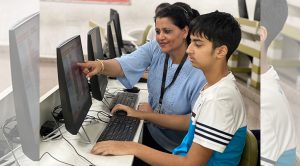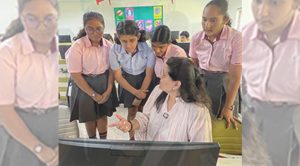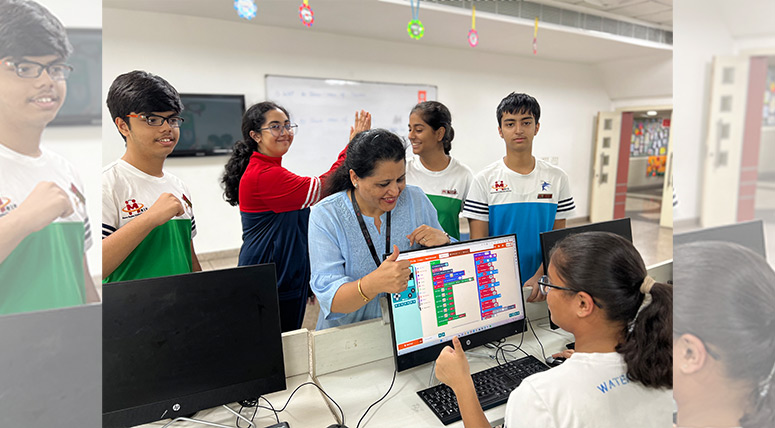Revolutionizing Educational Mindset
In a world driven by innovation and progress, technology has emerged as a powerful catalyst revolutionizing the landscape of education, paving the way for an immersive and transformative education like never before. With new opportunities for discovery, collaboration, and involvement, the incorporation of technology into education has completely changed the learning atmosphere. From interactive online platforms to virtual reality simulations, technology has revolutionized the way knowledge is imparted, acquired and shared. One school which has implemented a tech-driven approach within its school premises is Manav Rachna International School, Sec-51, Gurugram. It is amongst one of the top schools in India offering students the opportunity to study in an environment which is tech-driven. In this blog, we will look into the multifaceted role of technology in education, exploring its potential to enhance pedagogy, empower learners, bridge gaps, and shape the future of education.
Unlocking Boundless Knowledge and Resources: Empowering Quest for Information
Technology has completely altered the ways to access knowledge, and has transformed the way how individuals learn. In today’s times, students from the best international schools in Gurugram have access to a variety of information that is accessible in a few seconds. Instead of traditional textbooks, students have exposure to online tools like online libraries, e-books, digital content, etc

Moreover, technology has allowed students to learn more about a subject in a detailed manner, do extensive research, and access resources that can adapt to their learning patterns. Students may control their educational process and develop effective study habits based on in-depth comprehension and inquiry due to the wealth of information available online. Technology provides a variety of opinions and resources that advance their comprehension and critical thinking skills.
The best CBSE schools in India offer the facility of virtual classrooms to their students, so that they can interact with classmates from around the world while working on group projects and having conversations. This not only enhances their understanding of the subject matter but also cultivates essential skills like adaptability, teamwork, and communication. By interacting with a diverse range of individuals, students develop a global mindset and become better equipped to navigate the interconnected world they will encounter in their future endeavors.
Power of Personalized Learning: Embrace the Future with Adaptive Technologies
By embracing the power of personalized learning through adaptive techniques, students not only benefit from customized learning experiences but also gain valuable skills through interactive virtual classrooms. These technologies adapt the content, pace, and difficulty level based on individual performance, ensuring optimal learning outcomes. By focusing on each student’s specific needs and preferences through adaptive technologies, instructors may promote good study habits and allow students to learn at their own pace and in their preferred learning styles.
It is only through the help of technology which makes it possible to gather and analyze enormous volumes of data about student performances, preferred learning styles, and areas for development. Teachers can use this information to deliver specialized interventions, individualized feedback, and custom learning plans, all of which help students establish good study habits. Students in top CBSE schools in Gurugram receive individualized support, which aids in helping them concentrate on what needs attention and promotes motivation and a sense of self-efficacy.
Moving further, let’s understand how technology serves as a medium for collaboration
- Collaboration and Communication Tools
The educational environment has been completely transformed by technology, which also caters to the various demands and learning preferences of students. Data analytics and algorithms-driven adaptive learning systems have become potent tools that deliver individualized learning experiences based on each student’s strengths, and weaknesses.
To ensure the best learning results, adaptive technologies modify the instruction’s pace, material, and level of difficulty based on student performance. These technologies dynamically adapt the learning experience to meet each student’s unique needs by monitoring students’ answers, progress, and engagement with the subject matter. By allowing students to learn and grow at their own pace, this personalized approach to learning helps to promote effective study habits.
Technology allows you to collect and analyze enormous amounts of data about student performance, learning styles, and potential development areas. Teachers can use this information to understand more about the distinctive learning styles, aptitudes, and shortcomings of each student. With this information, they are more equipped to support students in creating effective study habits by offering focused interventions, individualized feedback, and customized learning strategies.

For instance, if a student is struggling with a specific concept, adaptive technologies can offer additional resources, such as interactive tutorials or practice exercises, to reinforce understanding and bridge the knowledge gap. By addressing students’ individual learning needs, educators create a supportive environment that encourages continuous improvement and cultivates strong study habits.
- Interactive and Engaging Learning Experiences
The use of technology in education extends beyond merely granting access to information in our technologically evolved environment. Its capacity to design dynamic, captivating lessons that hold students’ attention and make learning pleasurable and interesting are some of its main features.
Technology can improve learning through the use of educational software, multimedia presentations, gamification, and virtual reality technologies, among other things. By including interactive components, technology aids in students’ true interest in what they are learning, which boosts motivation and encourages active engagement in their studies. This engagement is crucial for the development of strong study habits.
Reading textbooks or paying attention to lectures are two examples of traditional teaching approaches that occasionally fail to completely engage learners. However, when technology is applied in the classroom environment, students are given the chance to connect with the content directly. Their involvement with the learning process is improved in the interactive and engaging atmosphere.
Teachers can capitalize on students’ curiosity and excitement for learning by using technology to design dynamic and exciting learning experiences. Experiences like these encourage involvement, in-depth learning, and knowledge retention over time. Students are no longer passive recipients of information but active participants in their education. This shift in the learning paradigm cultivates strong study habits by fostering curiosity, enthusiasm, and a genuine passion for lifelong learning.
Access to information is only one aspect of technology’s involvement in education. Constructing interactive and captivating learning environments that capture students’ attention, can completely alter the educational experience. Technology encourages active involvement, critical thinking, and problem-solving abilities—all crucial for forming good study habits—through the use of educational software, multimedia presentations, gamification, and virtual reality tools. By utilizing the possibilities of technology, teachers can motivate children, encourage a love of learning, and equip them to continue learning throughout their lives.
- Effective Time Management and Organization
Technology can serve as a powerful tool for enhancing time management and organizational skills. Students can utilize digital calendars, task management apps, and productivity tools to plan their study schedules, create goals, and track their progress. These technological aids assist in prioritizing tasks, managing deadlines, and avoiding procrastination. Students who use technology effectively, boost their productivity and academic achievement by developing disciplined study habits, managing their time effectively, and maintaining a planned study method.
Additionally, technology provides features like notifications, reminders, and progress tracking that help students keep on top of their projects, assignments, and learning objectives. Students can arrange their study materials, make digital notebooks, and streamline their workflows with the help of online resources and collaboration applications. These digital organizational systems promote efficiency, reduce the likelihood of missed deadlines, and encourage proactive study habits.
While technology offers immense benefits, it is important to strike a balance and promote digital wellness. Excessive use of technology can cause distractions, diminished concentration, and detrimental impacts on one’s physical and mental health. Therefore, it is essential to teach children the value of limiting screen time and establishing productive study habits. A well-rounded approach to learning must include encouraging breaks, exercise, and offline study. By incorporating these aspects, students can develop strong study habits that promote holistic well-being, ensuring that technology serves as a valuable tool rather than a distraction.
Educational institutions can implement policies and guidelines to promote responsible technology usage and digital well-being. Teaching students strategies for managing screen time, encouraging regular exercise and outdoor activities, and fostering offline study habits will contribute to their overall development and academic success. Students learn the value of self-regulation, self-care, and productive study habits by establishing a balance between technology and other facets of life.
In conclusion, it is critical to understand the significance of technology in education when looking for the top schools in Gurugram and India. Technology not only provides access to information but also has the power to revolutionize the learning experience and cultivate strong study habits.
By incorporating technology effectively, educators in the best CBSE schools in Gurugram and India can inspire students, foster their love for learning, and empower them to become lifelong learners. Students can access an infinite amount of knowledge and resources through technology, overcoming the constraints of conventional textbooks. Students can access specialized materials that improve their understanding and critical thinking abilities through online libraries, e-books, and instructional websites. Through adaptive technologies and data analytics, technology also offers personalized learning experiences that are tailored to each student’s individual needs and learning preferences. By leveraging collaboration and communication tools, students can engage in interactive sessions, fostering important skills such as communication, teamwork, and adaptability.
Moreover, technology creates interactive and engaging learning experiences that captivate students’ attention and promote active participation. By integrating educational software, multimedia presentations, and virtual reality tools, educators in the top schools in Gurugram create environments that foster curiosity, enthusiasm, and a genuine passion for lifelong learning.
Furthermore, technology aids in developing effective time management and organizational skills. Digital calendars, task management apps, and productivity tools assist students in planning their study schedules, setting goals, and tracking their progress. These tools, along with the guidance of the best CBSE schools in India, help students cultivate disciplined study habits and maintain a structured approach to their studies.
But it’s crucial to maintain equilibrium and encourage digital well-being. Too much screen time can harm children’s physical and mental health, therefore it’s necessary to teach youngsters how to regulate their screen time and develop good study habits. A well-rounded approach to learning must include encouraging breaks, exercise, and offline study.

Incorporating technology seamlessly and nurturing strong study habits are the keys to unlocking the potential for academic success in the top schools in Gurugram and India. Students in CBSE-affiliated schools can build successful study habits that support holistic well-being by striking the right balance between technology and other facets of life. In this approach, educational institutions support the growth of a generation of students who are prepared for the future and who will prosper in the digital era.
Author: Ms. Aradhna Manchanda, TGT Mathematics, MANAV RACHNA INTERNATIONAL SCHOOL, SEC -51, GURUGRAM





